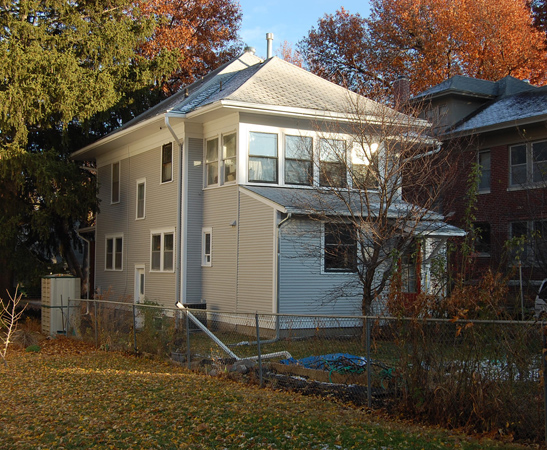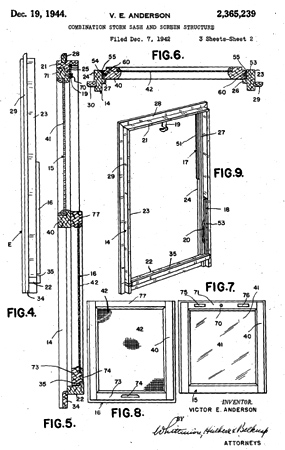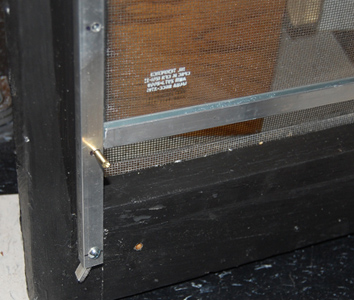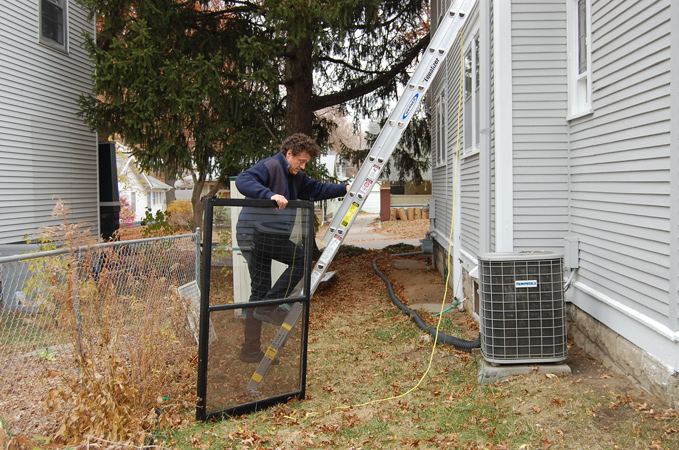
LINKS
email me
 Link to Spencerworks -- the
folks who really know how to make good old house storms
Link to Spencerworks -- the
folks who really know how to make good old house storms

So we've had this house for fifteen years now. And we recently had it painted because it needed it.
 This, in turn, led us to thinking about the sunroom and sunroom windows.
They have two sets of storm windows on them. One set is A style made by V. E. Anderson
in the 1940s and discussed in
patent 2,365,239
granted on Dec 19, 1944. These face out from the house towards the west. They're really pretty cool
as the patent drawings show. There are indpendent top and bottom sashes with window glass. These slide
onto galvanized T-shaped weatherstriping. The bottom of the 'T' is parallel to the glass and
fits into a groove in the side of the sash frame. The top storm sash stays in one place and has a screen
installed immediately below it, on the outside of the bottom glass storm window. When you slide the bottom
storm sash is raised the window is screened. And the sash is held up by a funky gizmo that you can
release by manipulating a wire. So now you have your choice of a screen to let the air flow, or a glazed
sash to provide extra insulation and stop air flow through the window in the way that storm windows
are designed to do. These windows had been somewhat messed up by previous owners and for fifteen years
I left them alone.
The rest of the windows in the sun room are of a different more usual sort.
On both the North and South sides of the sunroom the storms are ordinary oldfashioned house screens.
We don't have the glazed sashes that would have been made to put in during cooler weather. They were
likely thrown out some time ago by some previous owner. In any case, none of the windows were
doing a very good job keeping the room warm. Mostly that was because the
people we bought the house from did a pretty bad job of painting it for the sale 15 years ago,
and just left stuff half way as they should be. (Not that we did anything about it until now.)
And, of course, there has been some settling, so the regular window sashes are also in some need of work.
This, in turn, led us to thinking about the sunroom and sunroom windows.
They have two sets of storm windows on them. One set is A style made by V. E. Anderson
in the 1940s and discussed in
patent 2,365,239
granted on Dec 19, 1944. These face out from the house towards the west. They're really pretty cool
as the patent drawings show. There are indpendent top and bottom sashes with window glass. These slide
onto galvanized T-shaped weatherstriping. The bottom of the 'T' is parallel to the glass and
fits into a groove in the side of the sash frame. The top storm sash stays in one place and has a screen
installed immediately below it, on the outside of the bottom glass storm window. When you slide the bottom
storm sash is raised the window is screened. And the sash is held up by a funky gizmo that you can
release by manipulating a wire. So now you have your choice of a screen to let the air flow, or a glazed
sash to provide extra insulation and stop air flow through the window in the way that storm windows
are designed to do. These windows had been somewhat messed up by previous owners and for fifteen years
I left them alone.
The rest of the windows in the sun room are of a different more usual sort.
On both the North and South sides of the sunroom the storms are ordinary oldfashioned house screens.
We don't have the glazed sashes that would have been made to put in during cooler weather. They were
likely thrown out some time ago by some previous owner. In any case, none of the windows were
doing a very good job keeping the room warm. Mostly that was because the
people we bought the house from did a pretty bad job of painting it for the sale 15 years ago,
and just left stuff half way as they should be. (Not that we did anything about it until now.)
And, of course, there has been some settling, so the regular window sashes are also in some need of work.
But buying replacement windows is out of the question. They're not going to look original, they cost a fortune, and they never pay for themselves in energy savings. Good storm windows make much more sense and you can spend the extra money to do something that saves energy in a more cost-effective way. I'm one of those old house owners who has a visceral hatred of replacement windows.
So that leaves working on the windows. As you can see in the above photos, I got the Anderson patent storm windows working again and painted the sashes black to highlight the window frames on the white and grey of the house. I also replaced the cords to the window weights of the regular sashes and reputtied the old windows into the frames as needed. While I was at it I stripped the windows to the original pine on the inside and did the same with the window trim. All of this should be familiar from various old house information sources, including some books put out by John Leeke (himself formerly of Lincoln and frequent past contributor to Old House Journal among other sources of old house knowledge.
The side windows were another matter. I want both real storm windows and the ability to have air pass through. And I don't want to swap out storm sashes every year. And I want them to look right. And I can't afford to buy them from those who know what they are doing and who sell them at reasonable prices so that you don't wind up ripping your perfectly good windows out of your old house. I just don't have the money for even these reasonable prices. So I hatched a plan.

The basic idea is to use the storm sashes and make them into sashes for both storm windows and screens. And then have the lower storm window slide up out of the way of air flow when needed. So I pulled down the sashes and took off the existing screen. I cut a rebate in the top half around the hole and set glass into the hole, securing it with wooden strips cut to size. On the bottom I installed screen. And then I painted the whole sash black to look like it probably once did. On the back of the sash I made two tracks of aluminum, which I screwed to the sashes vertically. In this track runs a window of tempered quarter inch glass. Normally it is all the way down covering the opening where the screen is. But if I want air flow the window can be raised up and held with pins. The idea should be relatively clear from the accompanying photo.
The photos below show details of the window construction. The first photo shows the lower window glass in closed position. The second shows it held open by brass pins that hold it in position. The aluminum channel running horizontally in these photos is glued to the bottom edge of the tempered window glass to make it easier yet to move the window up and down. Since it is the same dimension as the channels the glass runs in, it also fits snugly against the wood of the window frame on the back side so as to prevent air outfiltration. What you can't see so easily is that I also have attached weather stripping inside the channel that the glass runs in, and that the stops on the bottom have nylon bushings to provide a cushion. The last photo shows a detail of some felt weatherstripping applied at the top.



The final set of photos shows me installing the first window. I'm still working on the others but will update the page when I get them done. I'll probably also add some observations about lessons learned for the project. At this point, including glass and tempered glass costs, paint, aluminum channel, screen, wood trim to hold the glass in the sash, and hardware it is costing out at about one hundred dollars per sash. A good bit less than either paying those who know how to make this sort of thing commercially, and even more cheaply than it would cost to pay window replacement racketeers.



I'm putting an unsolicited link on the sidebar to Spencerworks, a local Lincoln company that makes nice storm windows for older houses. I've seen their windows at a Restore Omaha conference in Omaha, and they are very nicely done - better than I could make myself. They also come very highly recommended by John Leeke (mentioned above), a guy I trust for old house advice. I've put the link here without any prompting from them, in hopes that people who don't have the energy to make their own, or who want something better than homemade will consider their product. Too many old houses are having their perfectly good older windows ripped out to install new replacements. If people spent that money on nicely made practical storms like these, they'd retain the old house fabric and have the benefits of modern storm windows at the same time. So I encourage people to consider this option instead of replacement windows. (John Leeke has some cost/benefit information about the relative costs of fixing vs. replacing old house windows on his very informative website.)
 Back to my Homepage.
Back to my Homepage.
 Back to my Homepage.
Back to my Homepage.
 The bathroom remodel page.
The bathroom remodel page.
 My kitchen cabinets
My kitchen cabinets The garage project page.
The garage project page.
 My Timberframe Cabin Page.
My Timberframe Cabin Page.  My Philosophy Page
My Philosophy Page
 link to patent docs for Anderson windows
link to patent docs for Anderson windows